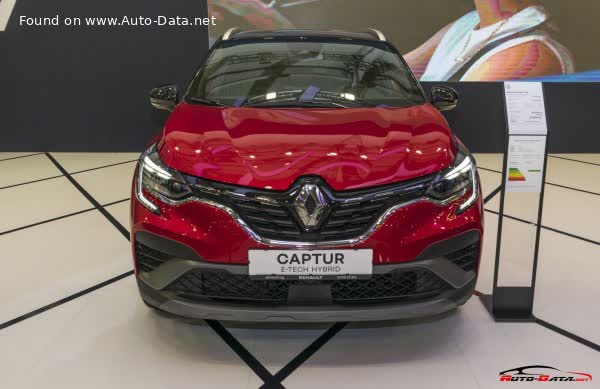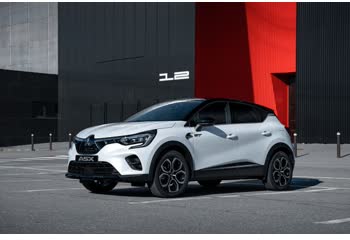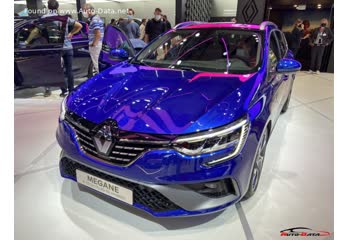Everything you need to know about specifications and performance - Renault Captur 2020 - E-TECH 1.6 (158 Hp) Plug-in Hybrid Multimode

Overview:
What is the engine capacity of a Renault Captur 2020?
The engine capacity of the Renault Captur 2020 is 1598.
Renault Captur 2020 How many horsepower?
The engine power of the Renault Captur 2020 is 92 Hp @ 5600 rpm..
What is the Renault Captur 2020 engine?
Renault Captur 2020 engine is H4M 630. (Click to see other cars using the same engine)
How powerful is the electrical system in the Renault Captur 2020?
The power of the electrical system in the Renault Captur 2020 is 158 Hp hp.
General:
Brand: Renault
Model: Captur
Generation: II
Modification (Engine): E-TECH 1.6 (158 Hp) Plug-in Hybrid Multimode
Start of production: June, 2020
End of production: May, 2022
Powertrain Architecture:Plug-In Hybrid Electric Vehicles (PHEVs)
Body type: Crossover
Seats: 5
Doors: 5
Engine:
Engine systems: Start & Stop System
Power: 92 hp @ 5600 rpm.
Power per litre: 57.6 hp/l
Torque: 144 nm @ 3200 rpm.
Engine Model/Code:H4M 630
Engine displacement: 1598
Number of cylinders: 4
Engine configuration: Inline
Number of valves per cylinder: 4
Fuel injection system: Multi-port manifold injection
Engine aspiration: Naturally aspirated Engine
Valvetrain: DOHC
Engine oil capacity: 4.5 l
Engine layout: Front, Transverse
Cylinder Bore: 78 mm
Piston Stroke: 83.6 mm
Performance:
Fuel Type: Petrol / electricity
Combined fuel consumption (WLTP): 1.5-1.6 l/100 km
Emission standard: Euro 6d
Acceleration 0 - 100 km/h: 10.1 sec
Acceleration 0 - 62 mph: 10.1 sec
Maximum speed: 173 km/h
Weight-to-power ratio: 9.9 kg/Hp, 101 Hp/tonne
Weight-to-torque ratio: 10.9 kg/Nm, 92.1 Nm/tonne
Max speed (electric): 135 km/h
Acceleration 0 - 60 mph: 9.6 sec
Electric system:
Net (usable) battery capacity: 9.8 kWh
Gross battery capacity: 10.46 kWh
Battery technology: Lithium-ion (Li-Ion)
Battery location: Below the floor, under the rear seats
System power: 158 hp
All-electric range: 50 km
Electric motor power: 67 hp
Electric motor Torque: 205 nm
Average Energy consumption: 17.3-18.3 kWh/100 km
Electric motor location: Integrated into the transmission
Average Energy consumption (WLTP): 17.3-18.3 kWh/100 km
All-electric range (WLTP): 50 km
Battery weight: 103 kg
Battery voltage: 346 V
Space:
Kerb Weight (kg): 1564
Max. weight (kg): 2060
Max. roof load: 80 kg
Max load (kg): 496
Trunk (boot) space - maximum: 1118 l
Trunk (boot) space - minimum: 265 l
Permitted trailer load with brakes (12%): 750 kg
Fuel tank capacity: 39 l
Permitted trailer load without brakes: 650 kg
Permitted towbar download: 75 kg
dimensions:
Length: 4227 mm
Width: 1797 mm
Height: 1576 mm
wheelbase: 2639 mm
Width with mirrors folded: 1797 mm
Width including mirrors: 2003 mm
Front track: 1560 mm
Rear (Back) track: 1547 mm
Front overhang: 876 mm
Rear overhang: 712 mm
Ride height (ground clearance): 142 mm
Minimum turning circle (turning diameter): 11.1 m
Powertrain, Suspension and Brakes:
Drivetrain Architecture: The Internal combustion Engine (ICE) and electric motor drive the front wheels of the car with the ability to work in full electric or mixed mode.
Drive wheel: Front wheel drive
Number of gears and type of gearbox: automatic transmission Multimode
Front brakes: Ventilated discs, 296x26 mm
Rear brakes: Disc, 290x13 mm
Assisting systems: ABS (Anti-lock braking system)
Steering type: Steering rack and pinion
Power steering: Electric Steering
Tires size: 215/65 R16; 215/60 R17; 215/55 R18
Wheel rims size: 16; 17; 18
Front suspension: Independent, type McPherson with coil Spring and anti-roll bar
Rear suspension: Coil spring, Torsion
See also

Last generation.
Its production began in 2024 until Now

Other generation.
Its production began in 2013 until 2017

Same engine. (H4M 630).
Its production began in 2023 until 2024

Same engine. (H4M 630).
Its production began in 2020 until Now
Write a comment